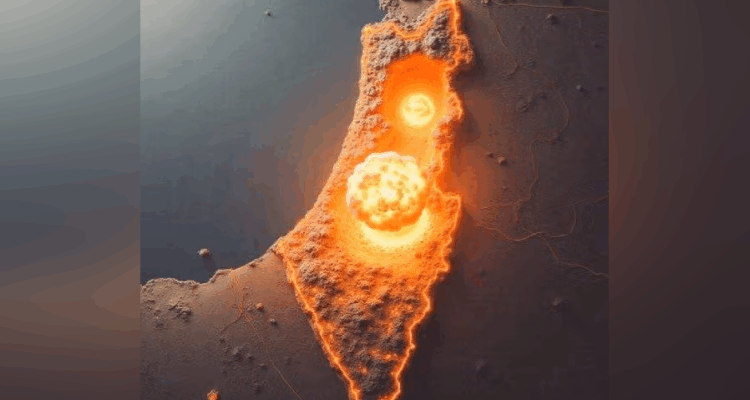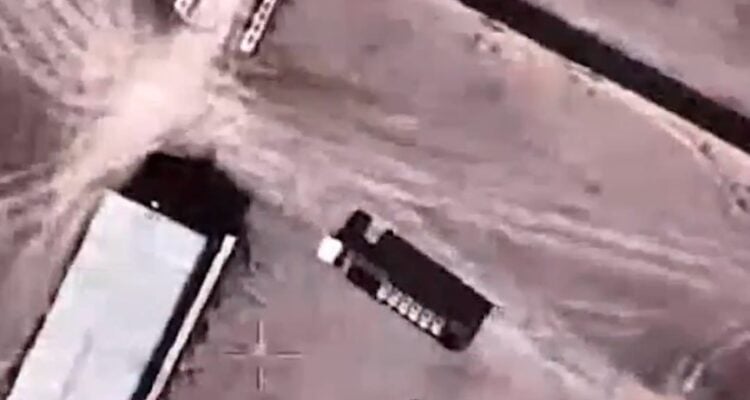
Iranian official makes veiled threat of nuclear attack on Israel :
Top aide to Iranian parliament speaker posts computer-generated image of Israel being hit by nuclear warheads.
A top adviser to a senior Iranian lawmaker posted a thinly veiled threat of nuclear war on Israel over the weekend.
On Saturday, Mehdi Mohammadi, a strategic adviser to the speaker of the Iranian parliament, Mohammad Bagher Ghalibaf, uploaded a computer-generated image showing a bird’s-eye view of Israel as the country is rocked by what appear to be two mushroom clouds.
The larger of the two explosions is centered roughly on Israel’s capital city, Jerusalem.
The post was later removed, Mohammadi’s account wrote, though a follow-up message including the same image was posted several hours later.
Mohammadi blamed the initial post on an errant page administrator and distanced himself from its apparent message, expressing opposition to the pursuit of an Iranian nuclear weapons program.
“Hello friends, this story was posted by the admin of my page but was then deleted minutes later,” Mohammadi wrote.
“I do not believe that building nuclear weapons can help improve Iran’s deterrence. At the very least, this issue is very complicated.”
“Just as having nuclear weapons did not prevent Iran from inflicting severe blows on the [Israeli] regime or [prevent] Ukraine from being able to strike Russia. The truth is that the military function of nuclear weapons is much more limited than is often thought.”
Iran’s leadership has repeatedly denied the country’s nuclear program is aimed at building nuclear weapons or even achieving an atomic weapons’ capacity.
However, according to the International Atomic Energy Agency, Iran has enriched close to 1,000 pounds of uranium to 60% purity, far beyond the single-digit levels of enrichment used for civilian energy production but close to the 90% needed for weapons-grade uranium.
WATCH: Iranian MP says, ‘We must be able to build as many nuclear weapons as we want within 24 hours’
Iranian MP Abolfazl Zohrevand declared he’s long believed Iran should be ready to respond to a nuclear attack and stand poised to mass-produce nuclear weapons in under 24 hours.
Iranian MP Abolfazl Zohrevand: We Need to Be Able to Produce as Many Nuclear Bombs as We Want in Less Than 24 Hours, and Equip Our Missiles with Tactical Nuclear Warheads pic.twitter.com/y7m9kf7dKD
— MEMRI (@MEMRIReports) July 11, 2025
Signs of the Times
The Revelation 13 Man controls the Beast Money System
What cryptocurrencies does Elon Musk own?
In 2021, Elon Musk confirmed that he owned BTC, ETH, and DOGE in a Twitter post.
Elon tweet about crypto
In the tweet, Musk playfully referred to these cryptocurrencies as ‘ascii hash strings’ to suggest that digital assets are nothing more than hashed sequences.
Of these three cryptocurrencies, Musk has given the most vocal support to DOGE. While he’s offered praise for BTC and ETH, Musk has also criticized both of these cryptocurrencies on different occasions.
Does Elon Musk own Dogecoin?
Musk has championed Dogecoin on multiple occasions. Musk has praised the cryptocurrency both for its humor and for its underlying technology.
Elon Musk tweet on Dogecoin
On an appearance on the Lex Fridman Podcast, Musk praised Dogecoin for its relatively fast transaction speeds and low fees. While he acknowledged that DOGE originally was created as a joke, he said that Dogecoin’s blockchain design made it better suited for transactions than Bitcoin.
While Musk has confirmed that he owns DOGE, it’s unclear how much he holds.
Let’s walk through some of the ways organizations affiliated with Elon Musk have supported Dogecoin.
At the time of writing, Tesla accepts DOGE as a form of payment.
The Boring Company accepts DOGE to pay for rides.
SpaceX announced DOGE-1 — a satellite mission 100% paid for in DOGE.
Elon Musk serves as the head of the newly-created Department of Government Efficiency (DOGE) — which was likely named as a nod to Dogecoin.
Should I invest in DOGE?
It’s important to remember that the value of DOGE is highly speculative.
While Bitcoin is an inflation-resistant store of value and Ethereum helps enable decentralized applications, DOGE currently has limited real world uses. In addition, the supply of DOGE is highly inflationary.
Does Elon Musk own Bitcoin?
In a tweet in 2018, Musk said that he owned .25 BTC that a friend sent him. It’s unknown whether Elon Musk currently owns Bitcoin.
In 2021, Elon Musk’s company Tesla bought $1.5 billion of BTC and introduced Bitcoin as a payment option. The stated reason for this purchase was for ‘more flexibility to further diversify and maximize returns for our cash’.
Just two months later, Tesla stopped accepting BTC as payment and began converting its existing Bitcoin holdings to cash. According to Musk, this move was intended to improve the company’s cash position in the face of uncertainty over COVID-19 lockdowns in China.
Has Elon Musk criticized Bitcoin?
Despite holding Bitcoin, Musk has criticized the cryptocurrency on several occasions.
Musk cited fossil fuel consumption associated with Bitcoin mining as a reason why Tesla would no longer accept BTC as payment.
Musk has also criticized the design of Bitcoin. In an appearance on the Lex Friedman Podcast, Musk said that Bitcoin was too slow because it was designed in 2008 — when Internet connectivity was much lower than it is today.
Does Elon Musk own Ethereum?
In 2021, Musk publicly confirmed that he owned Ethereum. However, he has criticized Ethereum for having slow transaction speeds and high fees.
Does Elon Musk own NFTs?
At this time, Musk does not endorse any NFT collection.
On an appearance on the Joe Rogan Experience, Musk criticized NFTs because the images themselves are not hosted directly on the blockchain. According to Musk, this means that NFTs rely on centralized entities.
Before Musk owned X, the company supported blockchain-verified NFT profile pictures. The company stopped supporting the feature after Musk took control of the platform.
Does Elon Musk have his own memecoins?
While Musk does not have a personal cryptocurrency, he has been linked to several memecoins, including:
Dogecoin (DOGE) – As mentioned earlier, Musk has been a vocal proponent of DOGE.
Floki Inu (FLOKI) – FLOKI is a cryptocurrency inspired by Musk’s pet Shiba Inu (also named Floki) — though the project has not been endorsed by Musk. In the past, Musk has publicly said that he does not own FLOKI.
Elon-themed tokens – Many projects have launched meme tokens with his name, though Musk has disavowed them.
You should be cautious of Elon Musk-branded memecoins. Many of these projects simply use Musk’s likeness to attract attention, but are not affiliated with Musk in any way. Musk has also said that none of his companies will create a crypto token.
Will blockchain be used in the US government?
A report in Bloomberg in January 2025 said that Elon Musk’s Department of Government Efficiency (DOGE) was considering using blockchain technology to track federal spending, secure data, and even manage buildings.
At this time, it’s unclear whether this idea will make it to DOGE’s final recommendations (due July 2026) or be implemented into law. In addition, it’s unclear which blockchain the government would use for this purpose.
However, it’s a clear sign that Elon Musk and the Trump Administration are pursuing crypto-friendly policies.
Gog and Magog Update
TRUE OR FALSE? Iran Boasts it Can Strike US and Israel Every Day for 2 Years

Iran says it can launch missiles at the United States and Israel every day for two years.
But experts speaking to Fox News say Tehran no longer has that power.
The warning came from top Iranian military officials, who claimed their underground missile bases and weapons stockpiles remain full.
“We have yet to demonstrate the majority of our defense capabilities,” said Maj. Gen. Ebrahim Jabbari of the Islamic Revolutionary Guard Corps.
In the same report, Maj. Gen. Yahya Rahim Safavi, a senior adviser to Supreme Leader Ayatollah Ali Khamenei, added that Iranian forces such as the Quds Force have not yet entered battle.
But according to military analysts and Western intelligence, Iran suffered major losses during the recent “12-Day War.”
Israeli strikes hit key missile production sites and storage facilities. The U.S. also joined with attacks on Iran’s nuclear infrastructure.
Iran started the war with up to 600 missile launchers and about 3,000 missiles.
“The regime has increasingly been forced to choose between using or losing these projectiles,” said Behnam Ben Taleblu, an Iran expert at the Foundation for Defense of Democracies.
Danny Citrinowicz, a former Israeli intelligence officer and Iran analyst, said the damage to production lines will make it hard for Iran to rebuild.
“Israel attacked every place that the Iranians manufacture missiles,” he told Fox News Digital.
Even if Iran can still launch missiles, Citrinowicz said, it could do so only in small numbers.
As for Iran’s ability to strike U.S. soil, analysts consider it unlikely.
Citrinowicz noted Iran might try to use its military presence in Venezuela but called that scenario “a long shot.”
More likely, any Iranian attack would target U.S. forces in the Middle East.
Iran’s setbacks were not limited to its missile program.
Can Kasapoglu, a Middle East military expert at the Hudson Institute, said Israel also targeted Iran’s nuclear infrastructure.
He added that Israel prioritized Iran’s most advanced missiles — solid-fuel, medium-range ballistic weapons that can reach speeds of Mach 10 and perform evasive maneuvers.
Despite these efforts, Iran remains the largest missile power in the region.
“We saw that during the war,” Kasapoglu said. “Even with interceptors from the U.S. and Israel, some missiles still got through.”
He also warned about Iran’s proxy forces, particularly the Houthis in Yemen.
With Chinese satellite assistance, the Houthis have resumed attacks on ships in the Red Sea.
One recent strike hit a Liberian-flagged Greek vessel.
“That’s the proxy I’m most concerned about,” Kasapoglu said.
Iran still poses threats across the region, especially at sea and through its network of militant allies.
But experts agree the country’s ability to launch sustained missile attacks is no longer what it once was.
While the war ended with a U.S.-brokered ceasefire, tensions remain high.
U.S. President Donald Trump has not publicly commented on the claims, though the Pentagon continues to monitor Iran’s movements.
IDF Chief of Staff Lt. Col. Eyal Zamir said Israeli forces remain on alert.